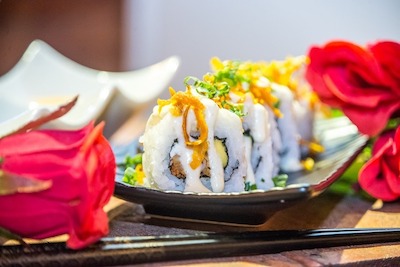We are reader supported. When you purchase through links on our site, we may earn an affiliate commission. Also, as an Amazon affiliate, we earn from qualifying purchases.
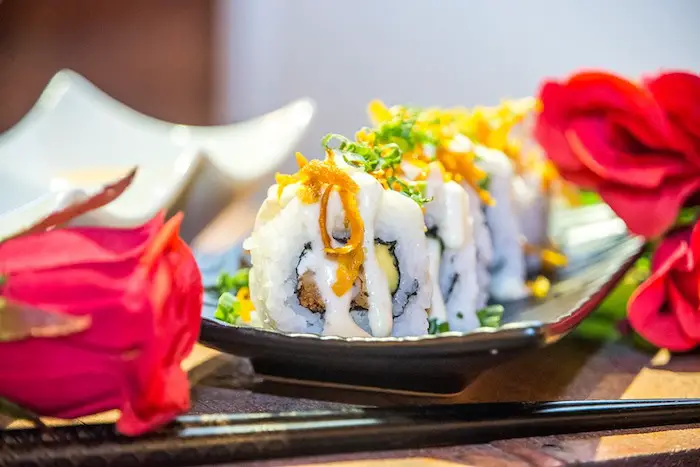
So, finally, you have decided to overcome the fear of the unknown and take a plunge into the world of sushi. After all, how long can someone live on pizzas and burgers? I welcome you to the group and promise to be your friend and guide to help you navigate your way through the diverse sushi experiences.
I know the kind of irrational fears some people have about this Japanese delicacy. My friends often ask me some of the most wired questions and that leads me to think about what people who don’t know where to look answers for things like these:
Does sushi mean only raw fish? Will it be old, stale fish, smelling pungent?
How to eat that stuff? Should I cut it with a knife and fork?
Will they laugh at me if I don’t know how to use chopsticks?
How do I know what is safe to order?
Should I know Japanese to place my order at a sushi restaurant?
Are there too many rules that I need to follow?
What are those black and green sauce? What to do with them?
What’s that pink stuff on the sushi plate?
Am I supposed to tip the chef or is it rude?
Well, well…these are just a few of the many questions I often hear from people who haven’t been to a sushi restaurant before. If that sounds like you then stay with me for the next few minutes as I take you through these sushi tips for beginners that no one will tell you!
#1. Familiarizing Yourself With A Few Sushi Jargons
As you enter a sushi restaurant, the chef may greet you by saying ‘irasshaimase’, which means welcome to the restaurant. It is their way of telling customers that they are happy and ready to serve food. Reply back by saying ‘Ojama shimasu’ or just smile and say ‘hello’.
If it’s your first time at a sushi restaurant, you can impress the chef by saying ‘Itadakimasu’ before the meal starts. In English that means ‘let’s eat’ or ‘I shall receive the food’. After the meal, thank the chef by saying ‘Gochisosama’ which means ‘Thank you for the meal’.
One of the most beautiful aspects of sushi is direct interaction with the chef. This may feel slightly intimidating to a sushi beginner and if you are not mentally prepared for face-to-face interaction, skip the bar experience for now and take a table instead.
When you have gained enough confidence, consider sitting at the bar because there’s nothing like watching the chef prepare your meal. Furthermore, being friendly with the chef can help you explore new flavors and the chef will get a better understanding of what you like.
Some other Japanese words you may use are ‘Konbanwa’ which means good evening and ‘Arigato gozaimasu’ which means thank you very much. These beautiful Japanese words reflect the tradition of sushi and your chef will be pleased.
If you are a sushi beginner, this will help you garner the chef’s attention and respect in no time. Some of the other basic sushi terms you need to be familiar with are:
- Maki – Roll
- Hosomaki –Thin Roll
- Futomaki – Fat Roll
- Temaki–Handroll
- Gunkanmaki–Battleship sushi
- Nigiri–Hand formed sushi
- Wasabi–Japanese horseradish paste
- Nori–Seaweed
- Shoyu–Soy Sauce
- Gari–Pickled ginger
- Neta–Fish
- Surimi –Imitation crab meat
#2. Choosing The Right Sushi Restaurant
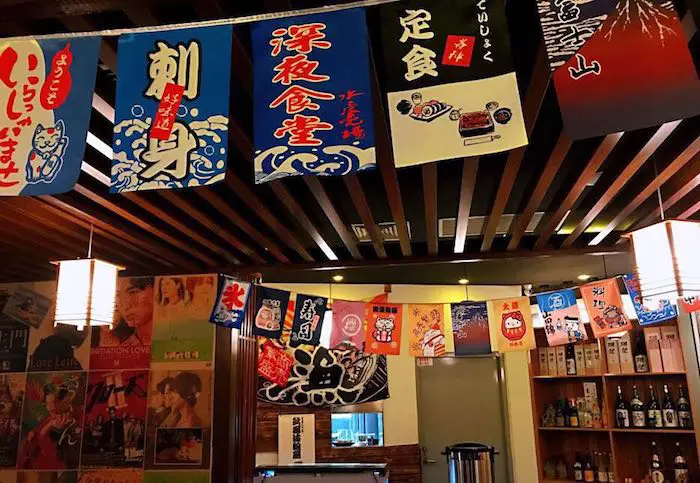
People planning their first trip to a sushi restaurant are often filled with apprehensions. Get over the stress and relax! EVERYBODY has a first time and the sushi chefs are used to having newbies frequently. No one’s going to judge you by what you order or how you eat.
In the next few sushi tips for beginners, I will tell you about the things you will find in a sushi restaurant and how to eat like a pro. Before that, let’s take a look at how to choose the right sushi restaurant:
Ask a friend who knows about the sushi restaurants in the city to accompany you. He will know the good and bad places, and you will be more comfortable in the company of a knowledgeable friend.
Do your research to find out where the local Japanese go to eat good sushi. The Japanese are meticulous people and if they think that a place is authentic then it probably is.
Many US sushi restaurants will have Japanese chefs but some may be exceptions. If you want to be extra confident about the place, call them and ask if the chef is Japanese.
When you don’t have a friend to help you, seek assistance from the online reviews about sushi restaurants in your city. Read a few reviews and you will get a general idea about their food and services.
#3. Identifying Things Inside A Typical Sushi Restaurant
Just like any other restaurant, each sushi place will be different in terms of interiors, seat arrangement, and vibes. However, most sushi restaurants are typically divided into two sections – the bar and table-chairs setting. The bar comprises a countertop with the chef behind the counter and tall bar stools on the other side for customers.
If you are dining alone or with a friend, sit at the bar for a more intimate dining experience and enjoy the interaction with the chef. Large groups or beginners who find it intimidating to interact with the chef may choose a table instead, which is more like the seating arrangement at any formal restaurant.
If you take your seat at the bar, you will find a wooden board or block in front of you. This is where the chef will keep the food. You will find a hot towel on the table. Use it to clean your hands, fold neatly and keep it back. You may use it again to wipe your hand clean after the meal.
There will be a pair of chopsticks and a bottle of soy sauce on the table. You may be given an extra plate for the side dishes. If you don’t know how to eat with chopsticks, there’s nothing to be ashamed of. Eat with your hands instead or politely ask for a fork. Read my article – can you eat sushi with a fork.
Now, you may pick the menu and order from there or if you have chosen an omakase meal, the chef will decide the menu for you. If you are a first-timer who hasn’t eaten sushi before, I would suggest that you don’t do an omakase so soon. Keep it for the third or fourth visit!
When your order arrives you will see a green paste and pink stuff at the side of the plate. The green paste is wasabi or Japanese horseradish. Use just a little on your nigiri or rolls to add extra heat (be careful as this thing is very spicy and may cause discomfort if used in excess).

The pink stuff is pickled ginger or gari which is consumed as a palate cleanser. Eat a little bit of it after every piece of sushi to be able to appreciate the delicate flavors of the next dish. The black sauce is soy sauce and better not add extra if you don’t need it. The chef already puts soya sauce in sushi to create a perfect balance of flavors.
#4. Deciding What To Order At A Sushi Restaurant
If you are seated at the table, you will see a menu that contains a list of sushi items available. For the beginners, I would recommend that you go with a cooked sushi roll, for example, a shrimp tempura roll or California roll.
Ask your friend who knows about sushi to place the order and if you are alone, you may ask for recommendations from the server. I have created an article that talks about the 15 Most Popular Cooked Sushi To Order.
If you are seated at the bar, let the chef know that this is your first sushi experience and you are delighted, but at the same time clueless about what to order. If you are unsure about eating the raw fish first time, tell the chef politely that you would like some cooked sushi rolls. In most restaurants, the chefs are understanding and they will be eager to help you with this exciting culinary journey.
While I usually advise first-timers to avoid the bar, it can sometimes be a positive experience to see the chef prepare raw fish and serve other customers. This will help you outgrow your own apprehensions and want to try raw fish sushi too.
The two most common types of raw fish used in sushi are tuna and salmon. For the sushi beginners, I would also recommend the following varieties of raw fish:
- Yellowtail
- Shrimp
- Crab
- Mackerel
- Trout
- Flatfish
- Abalone
- Sweetfish
- Seabass
- Blue marlin
There are some types of raw fish and seafood that need an acquired taste and they are best left for the next time. Examples are eel, sea urchin (uni), octopus, clams, squid, and so on. If you don’t recognize a fish or any other ingredient in the roll, don’t hesitate from asking the server or chef.
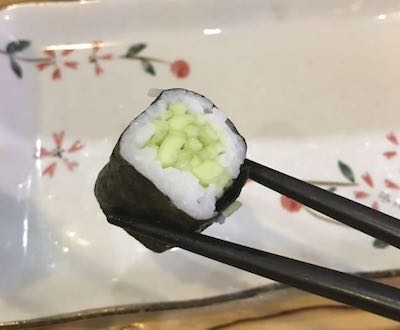
Also, remember that sushi doesn’t have to be all fish and seafood. Some of the most popular maki rolls are cucumber rolls and avocado rolls. There are numerous other veggies and fruits used as ingredients for making scrumptious nigirizushi and sushi rolls. Examples are mushrooms, bell peppers, carrots, mango, and so on.
#5. Eating Sushi With Confidence, Like A Pro!
When the server brings your order in a plate, receive it with a smile. Pour out a small amount of soy sauce in a small dish. If you know how to use chopsticks, hold them in your fingers or else feel comfortable eating with your hands.
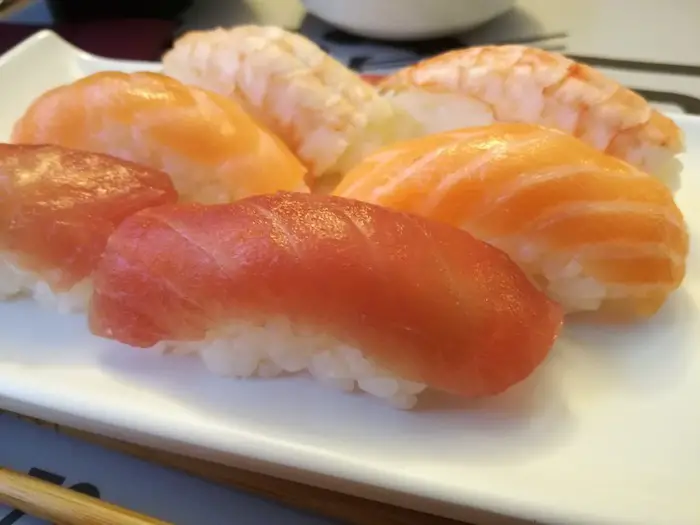
You may also request for a fork, but I would strongly advise that you don’t damage the perfect form of nigiri or sushi roll with a fork. Use your hand instead, no one’s going to judge you by the way you eat and if at all they do, don’t give a damn about them!
Pick your nigiri or sushi roll piece with the chopsticks or your hand, dip one side (preferably the fish side) in the soy sauce. Brush a little wasabi on it and put the entire piece in your mouth. If you find it difficult to eat it at once, take two bites at the most. The chef puts in a lot of effort to create the perfect form so it’s human to respect that and try to eat without breaking the pieces.
Chew the sushi thoroughly to ensure that you enjoy the delicate flavors of every ingredient. If you have ordered sake with sushi, this is the right time to take a sip. Now, take a small bite of the pickled ginger to cleanse the previous flavors from your mouth and get ready to eat the next one.
#6. Dos And Don’ts Of Sushi Eating
The Japanese are very particular about everything – their culture, traditions, lifestyle, and even food. With the globalization of sushi, the rules have become more liberal, but you are still expected to follow a few sushi etiquettes to ensure that you don’t offend the chef or fellow diners.
I have created an article that explains everything you need to know about sushi eating etiquettes – how to eat sushi in Japan. Here are some of the main highlights of the dos and don’ts of sushi eating:
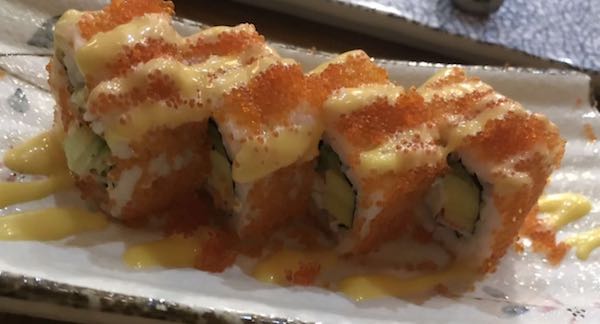
If it’s your first experience at sushi-eating, order cooked sushi rolls like spicy tuna roll, Boston roll, shrimp tempura roll, or California roll. It’s considered rude to leave food on the plate so order only what you know you can eat.
If you are seated at the bar, only ask for sushi or bear because the other items are handled by the servers, not the chef.
You may ask the sushi chef for recommendations but do not ask questions like ‘is the fish fresh’ because this is considered rude. Alternatively, you may ask which fish is available today.
Always seek permission before taking pictures of the sushi chef and don’t forget to tip him at the end. Don’t hand out the money directly. Keep it with the bill or buy a beer or sake for the chef as a mark of gratitude.
Don’t mix soy sauce and wasabi to create that ugly greenish-black condiment. Avoid slathering your sushi with that sauce mixture as it will overpower the delicate flavors of the dish.
Please bear in mind that no one’s going to throw you out of the restaurant or mock at you if you don’t know the sushi etiquettes or have no idea what to order. Every person has a first time and everyone makes mistakes. I hope these sushi tips for beginners make you more confident to try out this wonderful cuisine.

